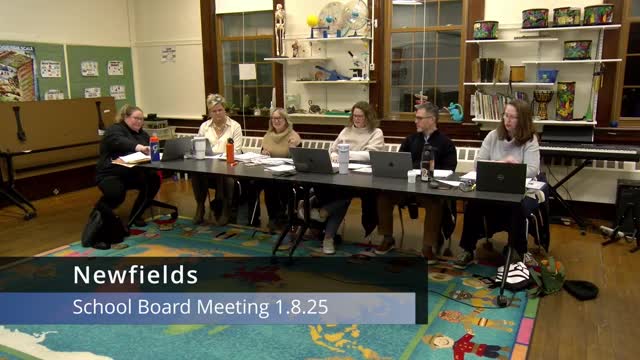Newfields administrators recommend $30,000 contingency for odor remediation in two classrooms; board to encumber funds pending monitoring
January 11, 2025 | Newfields School District, School Districts, New Hampshire
This article was created by AI summarizing key points discussed. AI makes mistakes, so for full details and context, please refer to the video of the full meeting. Please report any errors so we can fix them. Report an error »

School administrators told the board that two classrooms have experienced an intermittent odor problem that has kept them offline. Staff recounted months of testing and remediation efforts — including roof work, foam sealing and multiple inspections — that have reduced but not definitively eliminated the smell.
Chris Andrisky (associate superintendent) and district staff described a plan recommended by the facilities team and outside consultants: install two dedicated energy‑recovery ventilation units (roughly $15,000 each) plus charcoal filtration to mitigate any residual off‑gassing. Staff recommended a conservative approach: fund one unit from the current fiscal year’s available appropriation and draw the second unit from anticipated year‑end unassigned fund balance, for a total contingency of $30,000.
Board members questioned timing and whether to wait for warmer, more humid months that might cause the odor to return before spending the funds. Staff proposed an interim step: open an encumbered purchase order to reserve capacity with a vendor (which would appear as an encumbrance in the financials) but delay final purchase until the spring if monitoring suggests the odor has not returned. Molly (finance contact) said the district could open a purchase order and later modify or cancel it if final data show the units are unnecessary.
Administrators emphasized continued monitoring. The facilities team said that as of the meeting the smell was not present — a development staff described as encouraging but not conclusive given the short monitoring window and seasonal humidity effects.
Ending: The board accepted the staff recommendation to reserve (encumber) funds for the potential purchase and to continue close monitoring; staff will report back in spring and proceed with purchase only if monitoring and vendor scheduling justify it.
Chris Andrisky (associate superintendent) and district staff described a plan recommended by the facilities team and outside consultants: install two dedicated energy‑recovery ventilation units (roughly $15,000 each) plus charcoal filtration to mitigate any residual off‑gassing. Staff recommended a conservative approach: fund one unit from the current fiscal year’s available appropriation and draw the second unit from anticipated year‑end unassigned fund balance, for a total contingency of $30,000.
Board members questioned timing and whether to wait for warmer, more humid months that might cause the odor to return before spending the funds. Staff proposed an interim step: open an encumbered purchase order to reserve capacity with a vendor (which would appear as an encumbrance in the financials) but delay final purchase until the spring if monitoring suggests the odor has not returned. Molly (finance contact) said the district could open a purchase order and later modify or cancel it if final data show the units are unnecessary.
Administrators emphasized continued monitoring. The facilities team said that as of the meeting the smell was not present — a development staff described as encouraging but not conclusive given the short monitoring window and seasonal humidity effects.
Ending: The board accepted the staff recommendation to reserve (encumber) funds for the potential purchase and to continue close monitoring; staff will report back in spring and proceed with purchase only if monitoring and vendor scheduling justify it.
View the Full Meeting & All Its Details
This article offers just a summary. Unlock complete video, transcripts, and insights as a Founder Member.
✓
Watch full, unedited meeting videos
✓
Search every word spoken in unlimited transcripts
✓
AI summaries & real-time alerts (all government levels)
✓
Permanent access to expanding government content
30-day money-back guarantee

